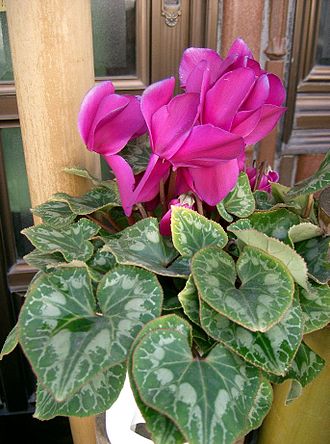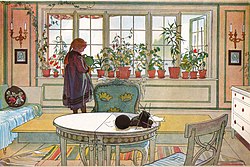Houseplant
A houseplant is any kind of decorative plant. People grow them indoors, sometimes in a house, but very often in an office or a shop.
Houses or public premises have conditions not as favorable for plants as in greenhouses. For example, the direction of light, low light, dry air, dust, drafts, uneven temperature. So, special techniques are used to get a healthy state and proper development of plants.[1] Conditions in public and office premises are usually even less favorable than in homes, so the most hardy indoor plants are grown there.
Benefits of houseplants
Feel and observe
One obvious advantage of keeping houseplants is the improvement in aesthetic quality that they provide. Some large palm varieties, can serve as a focus point for guests.[2]
Condition of the air
Houseplant may enhance indoor air quality. That is a key perk. NASA conducted a study to identify which plants are most effective at filtering out harmful chemicals.
Health
Taking care of plants, like taking care of people or animals, can have a positive effect on one's mental and emotional health.[3]
Therapeutic, preventative, and cosmetic
Plants and herbs with medical characteristics, such as Aloe Vera, are grown for human consumption.
Well-known houseplants
Houseplant Media
Still Life with Lemons, Oranges and a Rose, by Francisco de Zurbarán, 1633. Indoor citrus trees were popular in this era.
The earliest portrait of Charles Darwin, 1816, holding a potted houseplant
References
- ↑ Indoor Plants Kentucky Master Gardener Manual Chapter 14. [1]
- ↑ Plants at Home:The Benefits of Houseplants (PDF).
- ↑ Liao, Li-Shih (2022). Effects of Indoor Plants on Human Functions. Environmental Research and Public Health.










